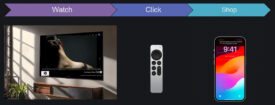Simplicity is key to shoppable TV solutions that scale, says Broadpeak

Broadpeak believes its Click2 interactive advertising capability will help broadcasters, streamers and pay-TV platforms introduce a shoppable TV experience that can be scaled quickly, as it requires only modest adjustments to a standard addressable advertising campaign.
According to Olivier Karra, cloud solutions marketing director at Broadpeak, shoppable TV characterises the way the TV industry can seek incremental revenue by attracting performance-focused advertisers looking for immediate business outcomes.
“The way to attract this category of advertiser is to acknowledge their business model, which is focused on clicks. That is what they are interested in and what they are willing to pay for,” he says.
As its name suggests, Click2 is all about generating clicks, as TV viewers use their remote control to accept a push-to-mobile offer that then links them to an ecommerce site.
Broadpeak is a leading tech vendor for the distribution of streaming TV, having pioneered the operator content delivery network (where service providers manage their own server capacity and caching, close to users) and multicast adaptive bitrate (which improves scalability for high-concurrency streaming). Among other solutions, it provides a server-side advertising insertion (SSAI) solution for addressable TV.
Click2 harnesses the standard ad creative that is used for addressable TV, without modifications, as the basis for what Karra calls a shoppable experience.
As with all SSAI, the ad creative is stitched into the content stream and delivered to end devices (set-top boxes, connected TV boxes, smart TVs, tablets etc). Separately, the SSAI stack also delivers simple SIMID-compatible interactive elements to the device. SIMID is the IAB’s Secure Interactive Media Interface Definition, which is a container that enables communication between the device player and any ad creative.

Push-to-mobile message
At the device, an open-source SIMID controller assembles the interactive creative in the player. The player resizes the viewing real estate so that when the ad is served there is space at the bottom of the screen for the interactive creative, which includes a push-to-mobile symbol. Other graphics, like a channel owner logo, can also be displayed here.
“We provide templates [for the interactive creative design] that publishers can use as their starting point, but these can be customised,” Karra explains.
Broadpeak believes push-to-mobile will work better than a QR code because, when sitting on a sofa, someone can reach and press a remote control faster than they can grab their phone and open the camera.
Once the viewer has selected the “push” instruction, a text message (or other form of mobile notification) is sent to their mobile phone or other mobile device. This message includes information about the product featured in the ad and a URL that directs the mobile to the advertiser’s ecommerce site.
The push-to-mobile notification will require user permission, so Broadpeak expects a role for broadcasters, streamers or platform providers in establishing a universal opt-in that covers these shoppable interactive ads.
Permissions will already state acceptance for targeted advertising and the expectation is that the media companies will use their direct consumer relationships (through service sign-ins and condition updates) to achieve the additional opt-in.
News, analysis, comment and community — Join The Media Leader
Pay-TV operator value-add
“Pay-TV operators almost always have the mobile phone number for a customer,” Karra adds, emphasising their value add if they partner content owners.
In the case of a broadcaster or streaming service, incentives could be offered to extend permissions to include push-to-mobile messages, he believes. This could be access to additional content on their service.
Alternatively, Karra suggests the push-to-mobile permission could be weaved into the conditions for a lower-cost streaming plan, using the same value exchange model that sees ads served in return for a lower subscription fee.
Besides texts to mobile phones, this concept could use in-app notifications if a consumer has a broadcaster streaming service app or platform owner companion app on their mobile or tablet. The notifications could also be sent as an email.
The messaging process is managed by the publisher or operator CRM (customer relationship management) platform. Click2 flags an ‘event’ to this system.
As Karra explains, the choice of notification format will be influenced by who is sending it (content owner or platform operator), the first-party data they hold, user/viewer preferences and the presence (or otherwise) of a content owner or platform owner app on the companion device.
In phase one, the second-screen experience is expected to be the same for every viewer who saw the targeted ad. Karra reckons this could evolve so the mobile ecommerce is also personalised. The ecommerce targeting might even take account of who is logged in to a streaming service (based on the user profile selected when the app was opened).
Karra notes that TV paved the way for more performance advertisers when it introduced targeted ads, as these reduce the cost of entry by allowing advertisers to buy only partial audiences — whether based on geography or signals such as interest, behaviour and intent. He believes shoppable TV will help attract advertisers that previously limited themselves to pure digital media like display and social.
Simplicity is key to scaling the shoppable TV opportunity, Karra explains, and Click2 has been designed to minimise changes to the typical SSAI workflow.
Broadpeak will be demonstrating Click2 at IBC in September.




